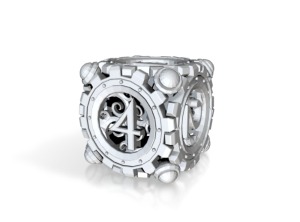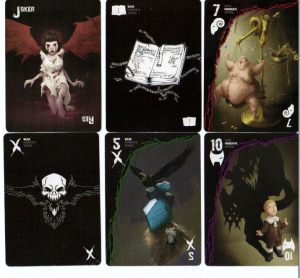Before you get all in a huff about randomness, I would like to look at a couple of different types of die-mechanics that I have seen over my limited years of gaming.
D6 - This mechanic has been made popular over the years by various game systems like Warhammer and Warhammer 40k, where a single D6 result determines the success of an action, or multiple D6 determine multiple successes. This is a very popular mechanic among miniatures games as it's the basis of the two most popular wargames out there, as well as board games like Risk and Axis and Allies. This is also the mechanic utilized in Spartan's miniatures games (Uncharted Seas, Firestorm Armada, and Dystopian Wars) and Flames of War, with some tweaks. The downside of this random mechanic is that there is a 16.7% chance of each possible result on the D6, and while these games will typically stack results (i.e. rolling a 4 or greater) to get the odds they desire, there is an equal chance of rolling a 1 as there is a 6, meaning that the variance can be relatively spread out. This can typically lead to lucky or unlucky outcomes, regardless of the player's decisions.
2D6 - This mechanic is found in a couple of the more popular board games (Monopoly, Catan series) as well as Warmachine/Hordes. At first glance, one might think that this isn't any different than the D6 mechanic, but that's not true. The 2D6 mechanic involves adding the results on the dice themselves to get a number, and that number decides the outcome of an event. The difference being that it's a weighted average hovering around the result 7, meaning that as you look at numbers further away from 7 (in either direction), they become increasingly less probable. In Monopoly, the player's decisions have no impact on the roll of the 2D6 and so it ends up being a game more of luck than most. Similarly, in Catan you are at the mercy of the roll of the dice to determine resources, however your decisions will often depend on the probability that one result will show up more often than another (a '10' result will not appear as often as a '5'). In Warmachine/Hordes, there are often spell effects that grant an effective +2 to the roll that you get or a boost or an additional die (which will shift the chart towards the results of 10 and 11, but will still be weighted). While this mechanic can be more reliable than the D6 mechanic, it still involves a level of randomness that can take some skill out of the equation.
52 Card - This mechanic is characteristic of Malifaux - a skirmish-scale gothic-horror miniatures game. This is a very interesting mechanic on a couple of levels, but at it's base, however, it's not much different than the D6 mechanic, where one card is flipped to determine whether it fits a "strong" "regular" or "weak" category - it could almost be replaced with a D3 mechanic. However, the difference is that Malifaux can throw in twists where a player could flip more cards and choose either the best of the bunch, or the worst, depending on the nature of the twist. Additionally, players have a hand of cards that will allow them to occasionally cheat fate and swap out the card they flipped for a card in their hand. While there's quite the level of variance, players do have some choice and their decisions can change the outcome. Even still, we see a game where randomness is present, and the skill can be better measured by ones ability to count cards (see: Blackjack) or generally keep track of a lot of probabilities and hope that your models will be able to do what you want them to do.
 Deck - Not to be confused with the 52 Card mechanic, this one is employed by pretty much every collectible card game (CCG) on the market, emulating the most successful card game out there: Magic: The Gathering. Other games out there that employ this mechanic are deck-building games like Acension or Resident Evil. The basic principle is that a player draws a hand of cards from their deck of cards in order to play them on their turn. In Magic, a player typically can only have 4 copies of the same card (unless it's basic land), meaning that their probabilities of drawing the card that they might want will be significantly diminished. This is a highly random game, as the best odds of drawing one card out of a deck - even if there are 4 copies - is 6.7%. This mechanic often compensates for this by allowing players to draw multiple cards at the beginning and during the rest of the game, increasing the probability of drawing that card, or letting players hold onto cards if they draw it too soon. While this seems more random than the dice mechanics, there are often cards to mitigate the random nature a little bit, with abilities like drawing additional cards, searching for specific cards, or playing cards that might already be 'dead'.
Deck - Not to be confused with the 52 Card mechanic, this one is employed by pretty much every collectible card game (CCG) on the market, emulating the most successful card game out there: Magic: The Gathering. Other games out there that employ this mechanic are deck-building games like Acension or Resident Evil. The basic principle is that a player draws a hand of cards from their deck of cards in order to play them on their turn. In Magic, a player typically can only have 4 copies of the same card (unless it's basic land), meaning that their probabilities of drawing the card that they might want will be significantly diminished. This is a highly random game, as the best odds of drawing one card out of a deck - even if there are 4 copies - is 6.7%. This mechanic often compensates for this by allowing players to draw multiple cards at the beginning and during the rest of the game, increasing the probability of drawing that card, or letting players hold onto cards if they draw it too soon. While this seems more random than the dice mechanics, there are often cards to mitigate the random nature a little bit, with abilities like drawing additional cards, searching for specific cards, or playing cards that might already be 'dead'. These are the main mechanics I have seen out there, but they are far from being the only ones. Other randomness mechanics include the famous D20 system employed by Dungeons and Dragons - which also uses other types of dice (D4, D6, D8, D10, and D12) or the D100 system employed by the Dark Heresy and Fantasy Flight Warhammer 40k role playing systems. The difference is that these mechanics are largely employed by RPGs, which are usually less about competition between the players and more about them cooperating against a common foe.
These are the main mechanics I have seen out there, but they are far from being the only ones. Other randomness mechanics include the famous D20 system employed by Dungeons and Dragons - which also uses other types of dice (D4, D6, D8, D10, and D12) or the D100 system employed by the Dark Heresy and Fantasy Flight Warhammer 40k role playing systems. The difference is that these mechanics are largely employed by RPGs, which are usually less about competition between the players and more about them cooperating against a common foe.In part 2 I will look at the non-random mechanics that exist in board games and miniatures games and ponder if it's possible to have a fun game without any such random mechanics while remaining fun and interesting to the players.




